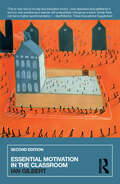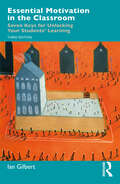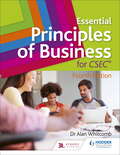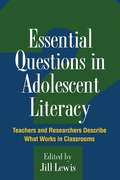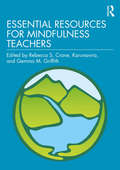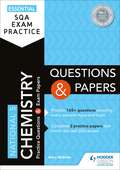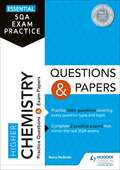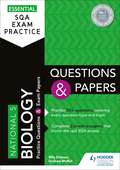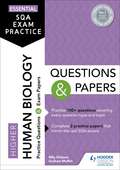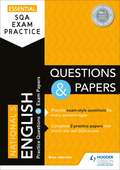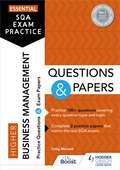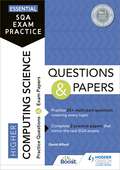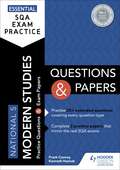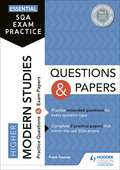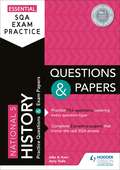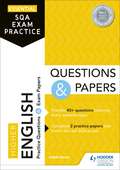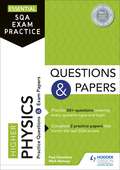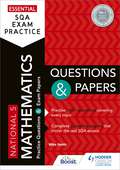- Table View
- List View
Essential Motivation in the Classroom: Resources And Activities To Inspire And Engage Your Students
by Ian GilbertPraise for the 1st edition: 'This is now one of my top five education books. .I was absorbed and uplifted by it and my own practice as a teacher will undoubtedly change as a result. Surely there can be no higher recommendation.' - Geoff Barton, Times Educational Supplement Essential Motivation in the Classroom is the definitive one-stop guide for teachers who want to know how to motivate children - and how children learn to motivate themselves. In the ten years since this book was first published, it has proven to be a best selling text that informs, inspires and amuses educationalist around the world. This fully updated and revised tenth anniversary edition continues to take the reader on a rollercoaster ride through the theories of teaching, learning and thinking. Ian Gilbert highlights the 'seven keys' of motivation, offering a range of strategies, ideas and insights to help learners become motivated from within. An entertaining and inspiring read, this book is full of useful, practical advice, ranging from motivational research from leading theorists to philosophical gems from Homer Simpson. Teachers in all sectors of education will find this book indispensable, helping them to change the culture of their classrooms and improve the effectiveness of their teaching.
Essential Motivation in the Classroom: Seven Keys for Unlocking Your Students' Learning
by Ian GilbertA great deal has changed in the word of education since Essential Motivation in the Classroom was first published in 2002.Then again, nothing has really changed at all: schools are still under pressure to raise standards, government ministers come and go along with various educational fads, initiatives and silver bullets, young people are still young people, and teachers are still looking for ways to motivate their students to do their very best in the classroom and beyond. Which is why this new, updated third edition of Ian Gilbert’s bestselling and classic text is still very much needed. Complete with a new preface and specially written ‘Notes from the future’ introducing each of the seven ‘keys to motivation,’ this book remains what it always was – an entertaining and inspiring read, full of useful, practical advice ranging from motivational research by leading theorists to philosophical gems from Homer Simpson.For teachers in all phases and sectors of education around the world, this fascinating and highly engaging book takes the reader on a roller-coaster ride of strategies, ideas and insights to help educators think again about classroom practice and school culture and to look with fresh eyes at motivation, relationships and achievement in their classrooms.
Essential Nursery Management: A Practitioner's Guide (Essential Guides for Early Years Practitioners)
by Susan HayWritten by a highly acclaimed expert in the field, this practical and accessible book addresses all the critical aspects of effective nursery management. From leadership skills and one-to-one skills, developing and monitoring the curriculum; and staff training and appraisals, to astute financial management; marketing strategies and evaluating your nursery's service, this new, fully revised edition of Essential Nursery Management recognizes the huge changes that have taken place in public policy and parental awareness which have inspired practitioners to strive for quality and sustainability in their child care provision. Supported by real-life case-studies, examples of policies, procedures and rotas that can be adapted by the reader, Essential Nursery Management takes a close look at the political and social context in which child care services are provided today and asks: What do parents expect? What do employers want for their workforces? What rights do children have? How can child care providers work together for the benefit of children and families? This book will be invaluable to anyone wishing to fully engage with the demanding role of managing any early years settings, whether as part of studying at GNVQ or Foundation degree level or in day-to-day practice.
Essential Principles of Business for CSEC: 4th Edition
by Alan WhitcombDiscover Principles of Business as a real-world subject through thought-provoking case studies and prepare effectively for the CSEC May/June 2019 examinations.-Develop knowledge systematically with each section focusing on a specific aspect of the syllabus, and clear syllabus references throughout.-Revise for the exam with unit summaries, in-chapter challenges, and MCQs. -Increase confidence with exam-type questions at the end of each unit and a full section dedicated to exam preparation and the School Based Assessment.-Ensure all three examined profile dimensions are developed with contextualised structured response questions.
Essential Principles of Business for CSEC: 4th Edition
by Alan WhitcombDiscover Principles of Business as a real-world subject through thought-provoking case studies and prepare effectively for the CSEC May/June 2019 examinations.-Develop knowledge systematically with each section focusing on a specific aspect of the syllabus, and clear syllabus references throughout.-Revise for the exam with unit summaries, in-chapter challenges, and MCQs. -Increase confidence with exam-type questions at the end of each unit and a full section dedicated to exam preparation and the School Based Assessment.-Ensure all three examined profile dimensions are developed with contextualised structured response questions.
Essential Questions in Adolescent Literacy
by Jill LewisIn each chapter of this unique volume, an exemplary teacher collaborates with a prominent scholar to present real-world strategies for putting literacy research to work in grades 5 12. These lively dialogues tackle key questions in adolescent literacy, including issues of motivation, critical thinking skills, content-area writing, differentiated instruction, assessment, English language learning, and technology. Suggestions for incorporating adolescents' out-of-school literacies and working with reading specialists and coaches show how to build connections between the classroom and wider communities. In-depth portraits of challenges and successes in the classroom, practical instructional tips, and stimulating questions for reflection make the book a valuable resource for in-service and preservice teachers.
Essential Resources for Mindfulness Teachers
by Rebecca S. CraneEssential Resources for Mindfulness Teachers offers the reader a wealth of knowledge about the explicit and implicit aspects of mindfulness-based teaching. The book focuses on how to develop the craft of teaching mindfulness-based courses and is divided into three parts. Part I addresses the explicit elements of mindfulness-based courses, such as how to offer meditation practices and inquiry. Part II investigates the subtle but powerful implicit qualities needed within the teacher to convey the essence of mindfulness. Part III is a series of chapters on the underpinnings, considerations, and theories surrounding the teaching of mindfulness-based courses, and includes a new framework for reflective practice – the Mindfulness-Based Interventions: Teaching and Learning Companion (the TLC). The book is a core companion text for both trainees and established mindfulness-based teachers, and is a resource you will return to again and again.
Essential SQA Exam Practice: From the publisher of How to Pass
by Barry McBrideExam board: SQALevel: National 5Subject: ChemistryFirst teaching: September 2017First exam: Summer 2018Practice makes permanent. Feel confident and prepared for the SQA National 5 Chemistry exam with this two-in-one book, containing practice questions for every question type and topic, plus two full practice papers.- Choose to revise by question type or topic: A simple grid enables you to pick particular question styles or course areas that you want to focus on, with answers provided at the back of the book- Understand what the examiner is looking for: Clear guidance on how to answer each question type is followed by plenty of questions so you can put the advice into practice, building essential exam skills- Remember more in your exam: Repeated and extended practice will give you a secure knowledge of the key areas of the course (chemical changes and structure; nature's chemistry; chemistry in society)- Familiarise yourself with the exam paper: Both practice papers mirror the language and layout of the real SQA papers; complete them in timed, exam-style conditions to increase your confidence before the exams- Find out how to achieve a better grade: Answers to the practice papers have commentaries for each question, with tips on writing successful answers and avoiding common mistakesFully up to date with SQA's requirementsThe questions, mark schemes and guidance in this practice book match the requirements of the revised SQA National 5 Chemistry specification for examination from 2018 onwards.
Essential SQA Exam Practice: From the publisher of How to Pass
by Barry McBrideExam board: SQALevel: HigherSubject: ChemistryFirst teaching: September 2018First exam: Summer 2019Practice makes permanent. Feel confident and prepared for the SQA Higher Chemistry exam with this two-in-one book, containing practice questions for every question type and topic, plus two full practice papers.- Choose to revise by question type or topic: A simple grid enables you to pick particular question styles or course areas that you want to focus on, with answers provided at the back of the book- Understand what the examiner is looking for: Clear guidance on how to answer each question type is followed by plenty of questions so you can put the advice into practice, building essential exam skills- Remember more in your exam: Repeated and extended practice will give you a secure knowledge of the key areas of the course (chemical changes and structure; nature's chemistry; chemistry in society; researching chemistry)- Familiarise yourself with the exam papers: Both practice papers mirror the language and layout of the real SQA papers; complete them in timed, exam-style conditions to increase your confidence before the exams- Find out how to achieve a better grade: Answers to the practice papers have commentaries for each question, with tips on writing successful answers and avoiding common mistakesFully up to date with SQA's requirementsThe questions, mark schemes and guidance in this practice book match the requirements of the revised SQA Higher Chemistry specification for examination from 2019 onwards.
Essential SQA Exam Practice: From the publisher of How to Pass
by Graham Moffat Billy DicksonExam board: SQALevel: National 5Subject: BiologyFirst teaching: September 2017First exam: Summer 2018Practice makes permanent. Feel confident and prepared for the SQA National 5 Biology exam with this two-in-one book, containing practice questions for every question type and topic, plus two full practice papers - all written by experienced examiners.- Choose to revise by question type or topic: A simple grid enables you to pick particular question styles or course areas that you want to focus on, with answers provided at the back of the book- Understand what the examiner is looking for: Clear guidance on how to answer each question type is followed by plenty of questions so you can put the advice into practice, building essential exam skills- Remember more in your exam: Repeated and extended practice will give you a secure knowledge of the key areas of the course (cell biology; biology: multicellular organisms; biology: life on Earth)- Familiarise yourself with the exam paper: Both practice papers mirror the language and layout of the real SQA papers; complete them in timed, exam-style conditions to increase your confidence before the exams- Find out how to achieve a better grade: Answers to the practice papers have commentaries for each question, with tips on writing successful answers and avoiding common mistakesFully up to date with SQA's requirementsThe questions, mark schemes and guidance in this practice book match the requirements of the revised SQA National 5 Biology specification for examination from 2018 onwards.
Essential SQA Exam Practice: From the publisher of How to Pass
by Graham Moffat Billy DicksonExam board: SQALevel: HigherSubject: BiologyFirst teaching: September 2018First exam: Summer 2019Practice makes permanent. Feel confident and prepared for the SQA Higher Biology exam with this two-in-one book, containing practice questions for every question type and topic, plus two full practice papers - all written by experienced examiners.- Choose to revise by question type or topic: A simple grid enables you to pick particular question styles or course areas that you want to focus on, with answers provided at the back of the book- Understand what the examiner is looking for: Clear guidance on how to answer each question type is followed by plenty of questions so you can put the advice into practice, building essential exam skills- Remember more in your exam: Repeated and extended practice will give you a secure knowledge of the key areas of the course (DNA and the genome; metabolism and survival; sustainability and interdependence)- Familiarise yourself with the exam papers: Both practice papers mirror the language and layout of the real SQA papers; complete them in timed, exam-style conditions to increase your confidence before the exams- Find out how to achieve a better grade: Answers to the practice papers have commentaries for each question, with tips on writing successful answers and avoiding common mistakesFully up to date with SQA's requirementsThe questions, mark schemes and guidance in this practice book match the requirements of the revised SQA Higher Biology specification for examination from 2019 onwards.
Essential SQA Exam Practice: From the publisher of How to Pass
by Graham Moffat Billy DicksonExam board: SQALevel: HigherSubject: Human BiologyFirst teaching: September 2018First exam: Summer 2019Practice makes permanent. Feel confident and prepared for the SQA Higher Human Biology exam with this two-in-one book, containing practice questions for every question type and topic, plus two full practice papers - all written by experienced examiners.- Choose to revise by question type or topic: A simple grid enables you to pick particular question styles or course areas that you want to focus on, with answers provided at the back of the book- Understand what the examiner is looking for: Clear guidance on how to answer each question type is followed by plenty of questions so you can put the advice into practice, building essential exam skills- Remember more in your exam: Repeated and extended practice will give you a secure knowledge of the key areas of the course (human cells; physiology and health; neurobiology and immunology)- Familiarise yourself with the exam papers: Both practice papers mirror the language and layout of the real SQA papers; complete them in timed, exam-style conditions to increase your confidence before the exams- Find out how to achieve a better grade: Answers to the practice papers have commentaries for each question, with tips on writing successful answers and avoiding common mistakesFully up to date with SQA's requirementsThe questions, mark schemes and guidance in this practice book match the requirements of the revised SQA Higher Human Biology specification for examination from 2019 onwards.
Essential SQA Exam Practice: From the publisher of How to Pass
by Brian JohnstonExam board: SQALevel: National 5Subject: EnglishFirst teaching: September 2017First exam: Summer 2018Practice makes permanent. Feel confident and prepared for the SQA National 5 English exam with this two-in-one book, containing practice questions for every question type, plus two full practice papers.- Choose which question types you want to revise: A simple grid enables you to pick particular question styles that you want to focus on, with answers provided at the back of the book - Understand what the examiner is looking for: Clear guidance on how to answer each question type is followed by plenty of questions so you can put the advice into practice, building essential exam skills- Remember more in your exam: Repeated and extended practice will give you a secure knowledge of the key areas of the course (Reading for Understanding, Analysis and Evaluation and Critical Reading)- Familiarise yourself with the exam papers: Both practice papers mirror the language and layout of the real SQA papers; complete them in timed, exam-style conditions to increase your confidence before the exams- Find out how to achieve a better grade: Answers to the practice papers have commentaries for each question, with tips on writing successful answers and avoiding common mistakesFully up to date with SQA's requirementsThe questions, mark schemes and guidance in this practice book match the requirements of the revised SQA National 5 English specification for examination from 2018 onwards.
Essential SQA Exam Practice: From the publisher of How to Pass
by Craig McLeodExam board: SQALevel: National 5Subject: Business ManagementFirst teaching: August 2017First exam: Summer 2018Practice makes permanent. Feel confident and prepared for the SQA National 5 Business Management exam with this two-in-one book, containing practice questions for every question type and topic, plus two full practice papers - all written by an experienced examiner.> Choose to revise by question type or topic: A simple grid enables you to pick particular question styles or course areas that you want to focus on, with answers provided at the back of the book> Remember more in your exam: Repeated and extended practice will give you a secure knowledge of the key areas of the course (understanding business; management of marketing; management of operations; management of people; management of finance)> Familiarise yourself with the exam paper: Both practice papers mirror the language and layout of the real SQA papers; complete them in timed, exam-style conditions to increase your confidence before the exams> Find out how to achieve a better grade: Answers to the practice papers have commentaries for each question, with tips on writing successful answers and avoiding common mistakesFully up to date with SQA's requirementsThe questions, mark schemes and guidance in this practice book match the requirements of the revised SQA National 5 Business Management specification for examination from 2018 onwards.
Essential SQA Exam Practice: From the publisher of How to Pass
by Craig McLeodExam board: SQALevel: National 5Subject: Business ManagementFirst teaching: August 2017First exam: Summer 2018Practice makes permanent. Feel confident and prepared for the SQA National 5 Business Management exam with this two-in-one book, containing practice questions for every question type and topic, plus two full practice papers - all written by an experienced examiner.> Choose to revise by question type or topic: A simple grid enables you to pick particular question styles or course areas that you want to focus on, with answers provided at the back of the book> Remember more in your exam: Repeated and extended practice will give you a secure knowledge of the key areas of the course (understanding business; management of marketing; management of operations; management of people; management of finance)> Familiarise yourself with the exam paper: Both practice papers mirror the language and layout of the real SQA papers; complete them in timed, exam-style conditions to increase your confidence before the exams> Find out how to achieve a better grade: Answers to the practice papers have commentaries for each question, with tips on writing successful answers and avoiding common mistakesFully up to date with SQA's requirementsThe questions, mark schemes and guidance in this practice book match the requirements of the revised SQA National 5 Business Management specification for examination from 2018 onwards.
Essential SQA Exam Practice: From the publisher of How to Pass
by Jim Morrison Craig McLeodExam board: SQALevel: HigherSubject: Business ManagementFirst teaching: August 2018First exam: Summer 2019Practice makes permanent. Feel confident and prepared for the SQA Higher Business Management exam with this two-in-one book, containing practice questions for every question type and topic, plus two full practice papers - all written by experienced examiners.> Choose to revise by question type or topic: A simple grid enables you to pick particular question styles or course areas that you want to focus on, with answers provided at the back of the book> Remember more in your exam: Repeated and extended practice will give you a secure knowledge of the key areas of the course (understanding business; management of marketing; management of operations; management of people; management of finance)> Familiarise yourself with the exam papers: Both practice papers mirror the language and layout of the real SQA papers; complete them in timed, exam-style conditions to increase your confidence before the exams> Find out how to achieve a better grade: Answers to the practice papers have commentaries for each question, with tips on writing successful answers and avoiding common mistakesFully up to date with SQA's requirementsThe questions, mark schemes and guidance in this practice book match the requirements of the revised SQA Higher Business Management specification for examination from 2019 onwards.
Essential SQA Exam Practice: From the publisher of How to Pass
by David AlfordExam board: SQALevel: HigherSubject: Computing ScienceFirst teaching: September 2018First exam: Summer 2019Practice makes permanent. Feel confident and prepared for the SQA Higher Computing Science exam with this two-in-one book, containing practice questions for every topic, plus two full practice papers - all written by an experienced marker.- Choose which topics you want to revise: A simple grid enables you to pick particular areas of the course that you want to answer questions on, with solutions provided at the back of the book- Remember more in your exam: Repeated and extended practice will give you a secure knowledge of the key areas of the course (software design and development; computer systems; database design and development; web design and development) Familiarise yourself with the exam paper: Both practice papers mirror the language and layout of the real SQA papers; complete them in timed, exam-style conditions to increase your confidence before the exams- Find out how to achieve a better grade: Answers to the practice papers have commentaries for each question, with tips on writing successful answers and avoiding common mistakesFully up to date with SQA's requirementsThe questions, mark schemes and guidance in this practice book match the requirements of the revised SQA Higher Computing Science specification for examination from 2019 onwards.
Essential SQA Exam Practice: From the publisher of How to Pass
by Frank Cooney Kenneth HannahExam board: SQALevel: National 5Subject: Modern StudiesFirst teaching: September 2017First exam: Summer 2018Practice makes permanent. Feel confident and prepared for the SQA National 5 Modern Studies exam with this two-in-one book, containing practice questions for every question type and topic, plus two full practice papers.- Choose to revise by question type or topic: A simple grid enables you to pick particular question styles or course areas that you want to focus on, with answers provided at the back of the book- Understand what the examiner is looking for: Clear guidance on how to answer each question type is followed by plenty of questions so you can put the advice into practice, building essential exam skills- Remember more in your exam: Repeated and extended practice will give you a secure knowledge of the key areas of the course (democracy in Scotland and the United Kingdom; social issues in the United Kingdom; international issues)- Familiarise yourself with the exam paper: Both practice papers mirror the language and layout of the real SQA papers; complete them in timed, exam-style conditions to increase your confidence before the exams- Find out how to achieve a better grade: Answers to the practice papers have commentaries for each question, with tips on writing successful answers and avoiding common mistakesFully up to date with SQA's requirementsThe questions, mark schemes and guidance in this practice book match the requirements of the revised SQA National 5 Modern Studies specification for examination from 2018 onwards.
Essential SQA Exam Practice: From the publisher of How to Pass
by Frank CooneyExam board: SQALevel: HigherSubject: Modern StudiesFirst teaching: September 2018First exam: Summer 2019Practice makes permanent. Feel confident and prepared for the SQA Higher Modern Studies exam with this two-in-one book, containing practice questions for every question type and topic, plus two full practice papers.- Choose to revise by question type or topic: A simple grid enables you to pick particular question styles or course areas that you want to focus on, with answers provided at the back of the book- Understand what the examiner is looking for: Clear guidance on how to answer each question type is followed by plenty of questions so you can put the advice into practice, building essential exam skills- Remember more in your exam: Repeated and extended practice will give you a secure knowledge of the key areas of the course (democracy in Scotland and the United Kingdom; social issues in the United Kingdom; international issues)- Familiarise yourself with the exam papers: Both practice papers mirror the language and layout of the real SQA papers; complete them in timed, exam-style conditions to increase your confidence before the exams- Find out how to achieve a better grade: Answers to the practice papers have commentaries for each question, with tips on writing successful answers and avoiding common mistakesFully up to date with SQA's requirementsThe questions, mark schemes and guidance in this practice book match the requirements of the revised SQA Higher Modern Studies specification for examination from 2019 onwards.
Essential SQA Exam Practice: From the publisher of How to Pass
by Hodder GibsonExam board: SQALevel: HigherSubject: HistoryFirst teaching: September 2018First exam: Summer 2019Practice makes permanent. Feel confident and prepared for the SQA Higher History exam with this two-in-one book, containing practice questions for every question type and the most popular topics, plus two practice papers.- Choose to revise by question type or topic: A simple grid enables you to pick particular question styles or course areas that you want to focus on, with answers provided at the back of the book- Understand what the examiner is looking for: Clear guidance on how to answer each question type is followed by plenty of questions so you can put the advice into practice, building essential exam skills- Remember more in your exam: Repeated and extended practice will give you a secure knowledge of the key developments in British, European, world and Scottish history- Familiarise yourself with the exam papers: Both practice papers mirror the language and layout of the real SQA papers; complete them in timed, exam-style conditions to increase your confidence before the exams- Find out how to achieve a better grade: Answers to the practice papers have commentaries for each question, with tips on writing successful answers and avoiding common mistakesFully up to date with SQA's requirementsThe questions, mark schemes and guidance in this practice book match the requirements of the revised SQA Higher History specification for examination from 2019 onwards.This book covers the following topics:The British, European and world paper, Section 1: British:- Church, State and Feudal Society, 1066-1406- The Century of Revolutions, 1603-1702- The Atlantic Slave Trade- Britain, 1851-1951- Britain and Ireland, 1900-1985The British, European and world paper, Section 2 - European and World:- The Crusades, 1071-1204- The American Revolution, 1763-1787- The French Revolution, to 1799- Germany, 1815-1939- Italy, 1815-1939- Russia, 1881-1921- USA, 1918-1968- Appeasement and the Road to War, to 1939- The Cold War, 1945-1989The Scottish Paper:- The Wars of Independence, 1249-1328- The Age of the Reformation, 1542-1603- The Treaty of Union, 1689-1740- Migration and Empire, 1830-1939- The Impact of the Great War, 1914-1928
Essential SQA Exam Practice: From the publisher of How to Pass
by John Kerr Jerry TealeExam board: SQALevel: National 5Subject: HistoryFirst teaching: September 2017First exam: Summer 2018Practice makes permanent. Feel confident and prepared for the SQA National 5 History exam with this two-in-one book, containing practice questions for every question type and the most popular topics, plus two full practice papers - all written by experienced examiners.- Choose to revise by question type or topic: A simple grid enables you to pick particular question styles or course areas that you want to focus on, with answers provided at the back of the book- Understand what the examiner is looking for: Clear guidance on how to answer each question type is followed by plenty of questions so you can put the advice into practice, building essential exam skills- Remember more in your exam: Repeated and extended practice will give you a secure knowledge of the key developments in Scottish, British, European and World history- Familiarise yourself with the exam paper: Both practice papers mirror the language and layout of the real SQA papers; complete them in timed, exam-style conditions to increase your confidence before the exams- Find out how to achieve a better grade: Answers to the practice papers have commentaries for each question, with tips on writing successful answers and avoiding common mistakesFully up to date with SQA's requirementsThe questions, mark schemes and guidance in this practice book match the requirements of the revised SQA National 5 History specification for examination from 2018 onwards.This book covers the following topics:Section 1: Scottish contexts:- The Wars of Independence, 1286-1328- Mary Queen of Scots and the Reformation, 1542-1587- Migration and Empire, 1830-1939- The Era of the Great War, 1900-1928Section 2: British contexts:- The Atlantic Slave Trade, 1770-1807 - Changing Britain, 1760-1914 - The Making of Modern Britain, 1880-1951 Section 3: European and World contexts:- Hitler and Nazi Germany, 1919-1939 - Red Flag: Lenin and the Russian Revolution, 1894-1921 - Free at Last? Civil Rights in the USA, 1918-1968 - Appeasement and the Road to War, 1918-1939 - World War II, 1939-1945 - The Cold War, 1945-1989
Essential SQA Exam Practice: From the publisher of How to Pass
by Judith HorneExam board: SQALevel: HigherSubject: EnglishFirst teaching: September 2018First exam: Summer 2019Practice makes permanent. Feel confident and prepared for the SQA Higher English exam with this two-in-one book, containing practice questions for every question type, plus two full practice papers - all written by an experienced examiner.- Choose which question types you want to revise: A simple grid enables you to pick particular question styles that you want to focus on, with answers provided at the back of the book - Understand what the examiner is looking for: Clear guidance on how to answer each question type is followed by plenty of questions so you can put the advice into practice, building essential exam skills- Remember more in your exam: Repeated and extended practice will give you a secure knowledge of the key areas of the course (Reading for Understanding, Analysis and Evaluation and Critical Reading)- Familiarise yourself with the exam papers: Both practice papers mirror the language and layout of the real SQA papers; complete them in timed, exam-style conditions to increase your confidence before the exams- Find out how to achieve a better grade: Answers to the practice papers have commentaries for each question, with tips on writing successful answers and avoiding common mistakesFully up to date with SQA's requirementsThe questions, mark schemes and guidance in this practice book match the requirements of the revised SQA Higher English specification for examination from 2019 onwards.
Essential SQA Exam Practice: From the publisher of How to Pass
by Paul Chambers Mark RamsayExam board: SQALevel: HigherSubject: PhysicsFirst teaching: September 2018First exam: Summer 2019Practice makes permanent. Feel confident and prepared for the SQA Higher Physics exam with this two-in-one book, containing practice questions for every question type and topic, plus two full practice papers - all written by experienced examiners.- Choose to revise by question type or topic: A simple grid enables you to pick particular question styles or course areas that you want to focus on, with answers provided at the back of the book- Understand what the examiner is looking for: Clear guidance on how to answer each question type is followed by plenty of questions so you can put the advice into practice, building essential exam skills- Remember more in your exam: Repeated and extended practice will give you a secure knowledge of the key areas of the course (our dynamic universe; particles and waves; electricity)- Familiarise yourself with the exam paper: Both practice papers mirror the language and layout of the real SQA papers; complete them in timed, exam-style conditions to increase your confidence before the exams- Find out how to achieve a better grade: Answers to the practice papers have commentaries for each question, with tips on writing successful answers and avoiding common mistakesFully up to date with SQA's requirementsThe questions, mark schemes and guidance in this practice book match the requirements of the revised SQA Higher Physics specification for examination from 2019 onwards.
Essential SQA Exam Practice: From the publisher of How to Pass
by Mike SmithExam board: SQALevel: National 5Subject: MathematicsFirst teaching: September 2017First exam: Summer 2018Practice makes permanent. Feel confident and prepared for the SQA National 5 Maths exam with this two-in-one book, containing practice questions for every topic, plus two full practice papers - all written by an experienced examiner.- Choose which topics you want to revise: A simple grid enables you to pick particular areas of the course that you want to answer questions on, with solutions provided at the back of the book- Remember more in your exam: Repeated and extended practice of calculator and non-calculator questions will improve your numerical, algebraic, geometric, trigonometric, statistical and reasoning skills- Familiarise yourself with the exam papers: Both practice papers mirror the language and layout of the real SQA papers; complete them in timed, exam-style conditions to increase your confidence before the exams- Find out how to achieve a better grade: Answers to the practice papers have commentaries for each question, with tips on writing successful answers and avoiding common mistakesFully up to date with SQA's requirementsThe questions, mark schemes and guidance in this practice book match the requirements of the revised SQA National 5 Maths specification for examination from 2018 onwards.
Essential SQA Exam Practice: From the publisher of How to Pass
by Mike SmithExam board: SQALevel: National 5Subject: MathematicsFirst teaching: September 2017First exam: Summer 2018Practice makes permanent. Feel confident and prepared for the SQA National 5 Maths exam with this two-in-one book, containing practice questions for every topic, plus two full practice papers - all written by an experienced examiner.- Choose which topics you want to revise: A simple grid enables you to pick particular areas of the course that you want to answer questions on, with solutions provided at the back of the book- Remember more in your exam: Repeated and extended practice of calculator and non-calculator questions will improve your numerical, algebraic, geometric, trigonometric, statistical and reasoning skills- Familiarise yourself with the exam papers: Both practice papers mirror the language and layout of the real SQA papers; complete them in timed, exam-style conditions to increase your confidence before the exams- Find out how to achieve a better grade: Answers to the practice papers have commentaries for each question, with tips on writing successful answers and avoiding common mistakesFully up to date with SQA's requirementsThe questions, mark schemes and guidance in this practice book match the requirements of the revised SQA National 5 Maths specification for examination from 2018 onwards.
